A GUIDE TO LITERARY ANALYSIS The stylistic analysis

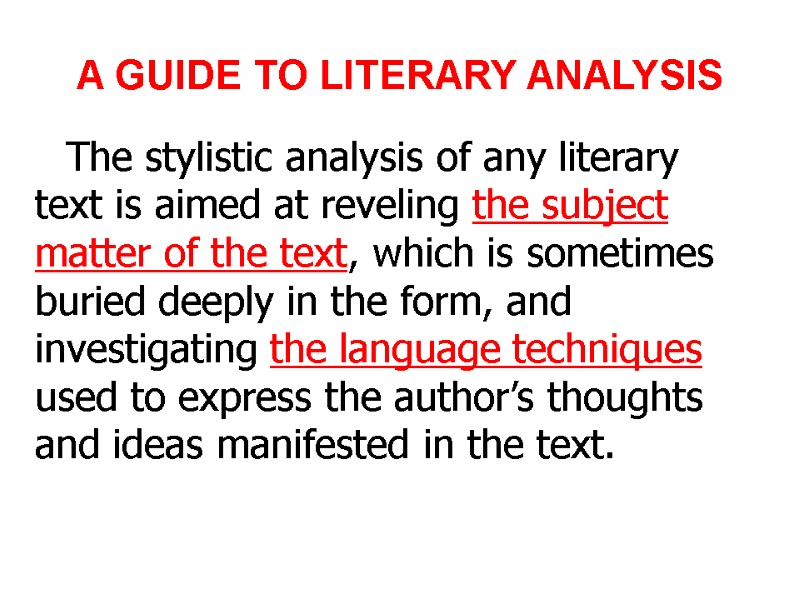
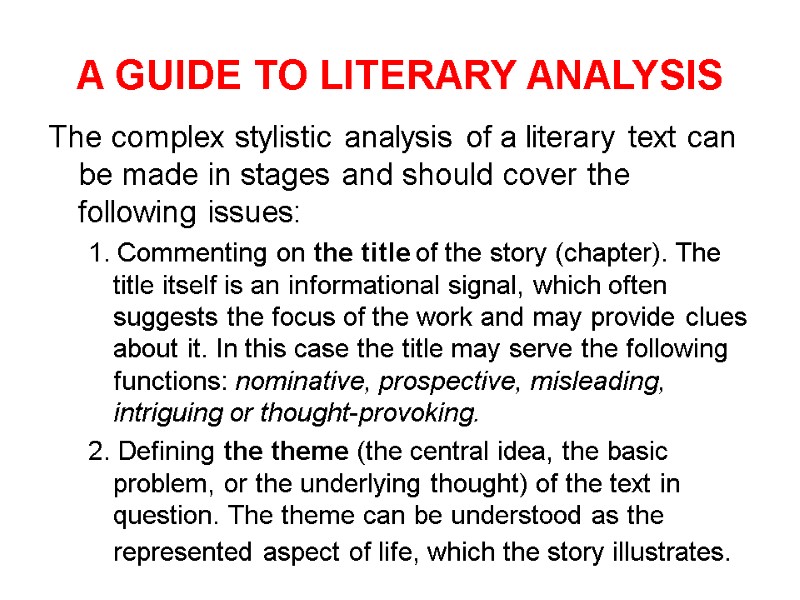
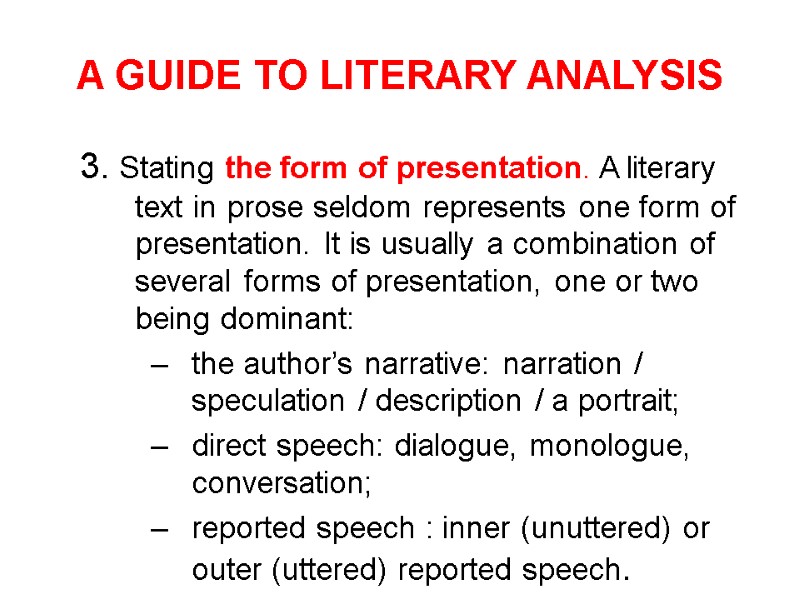
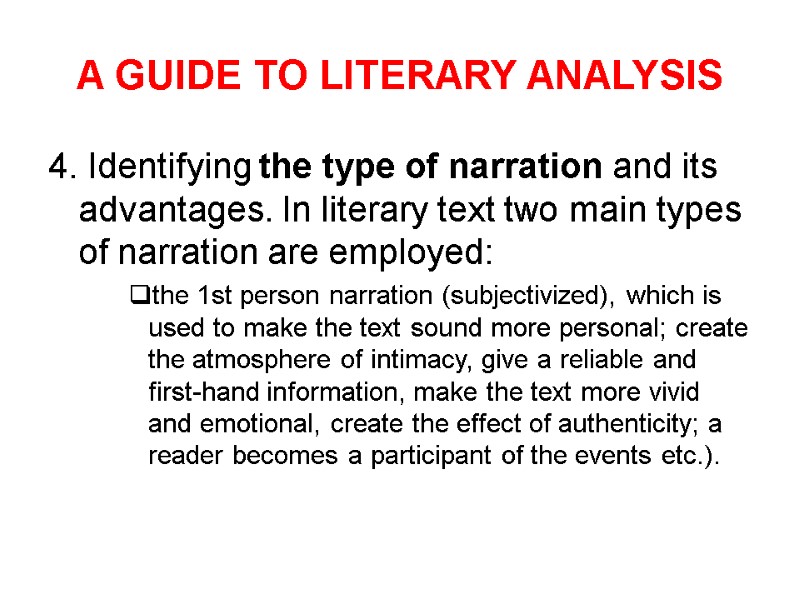
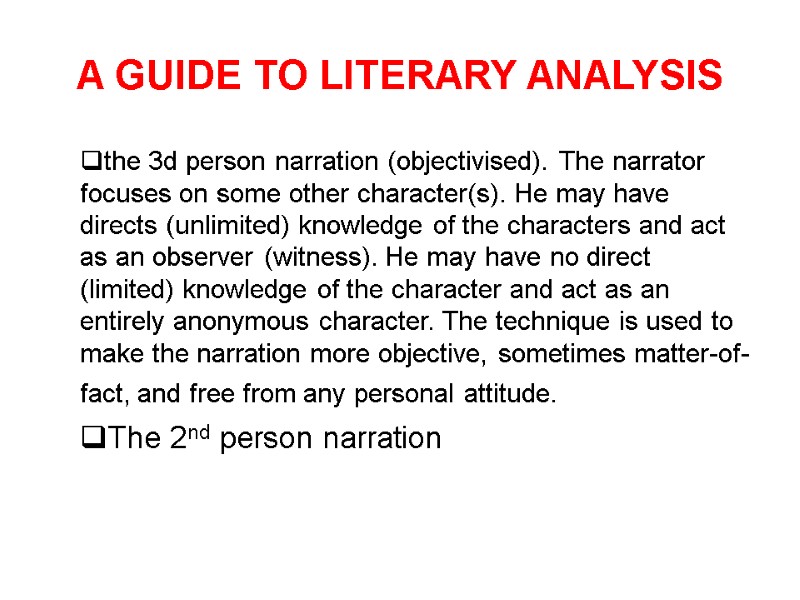
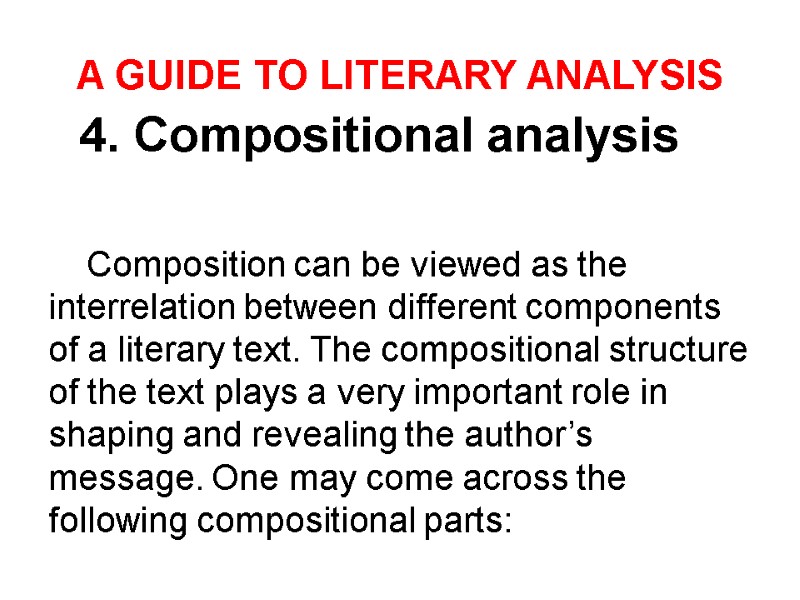
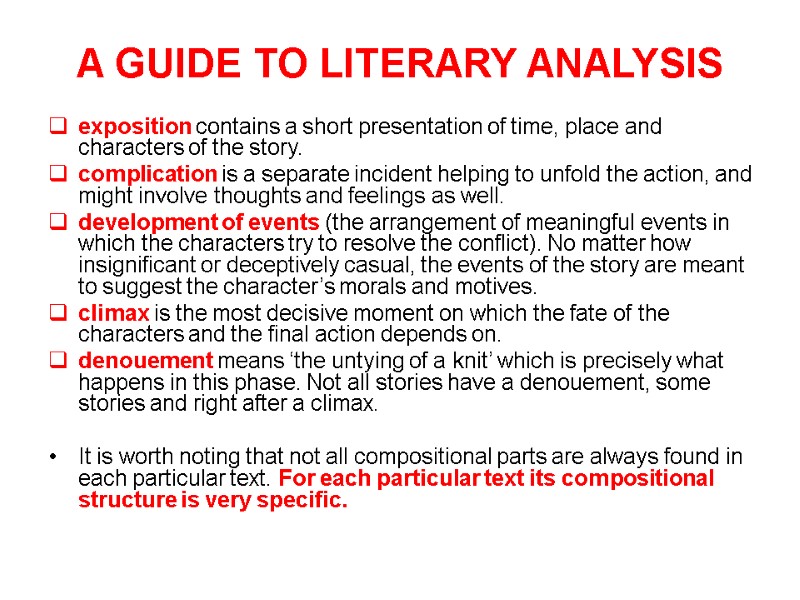
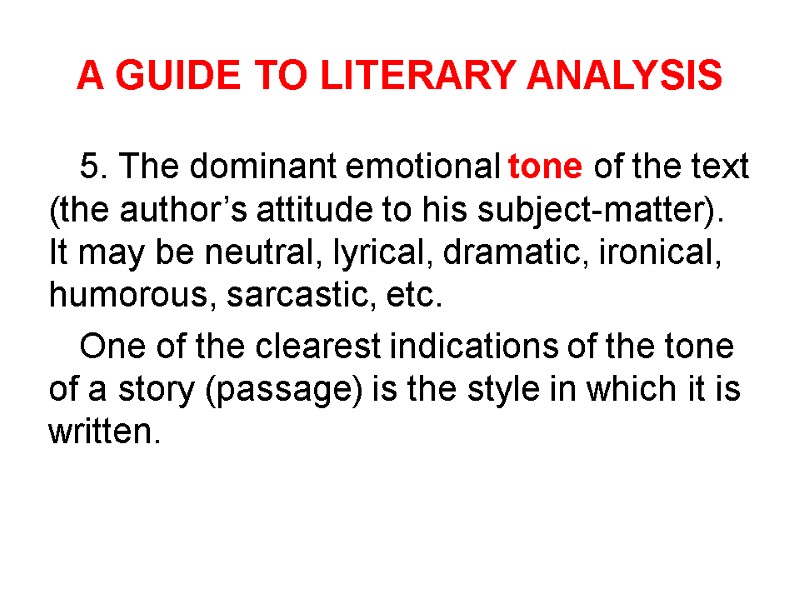
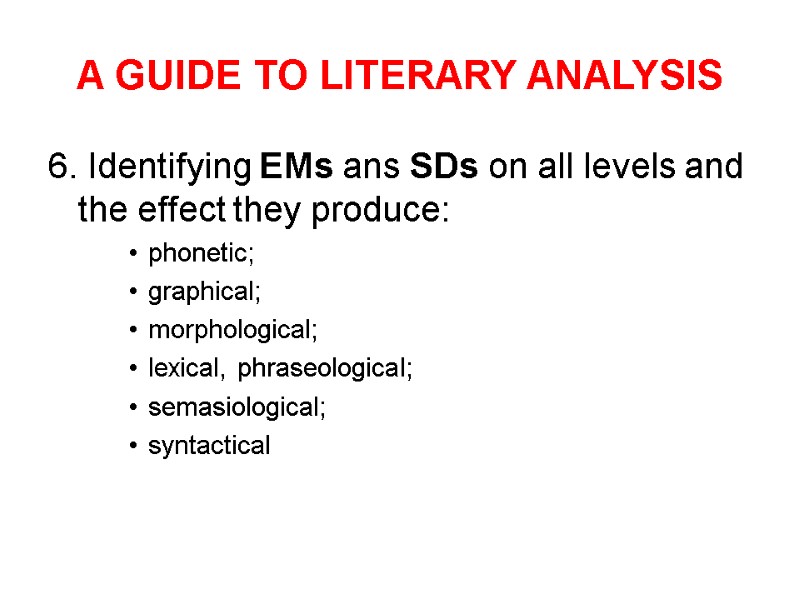
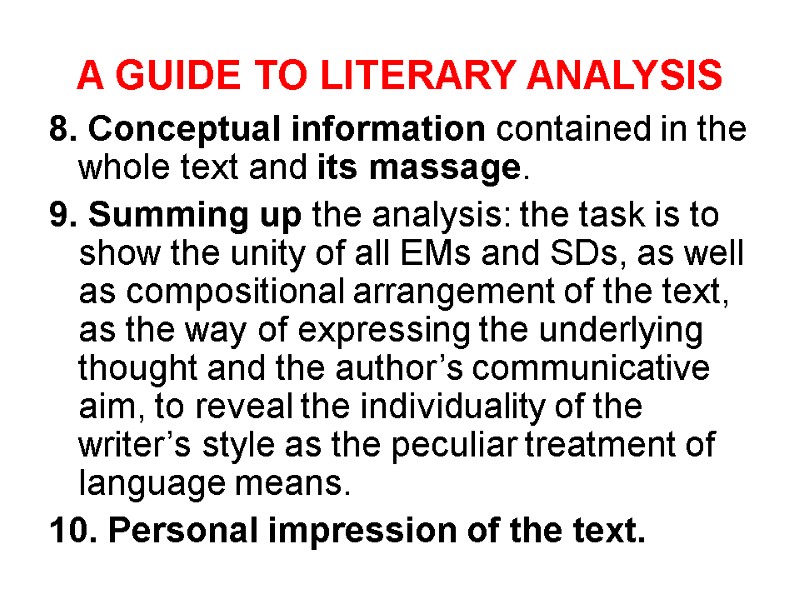
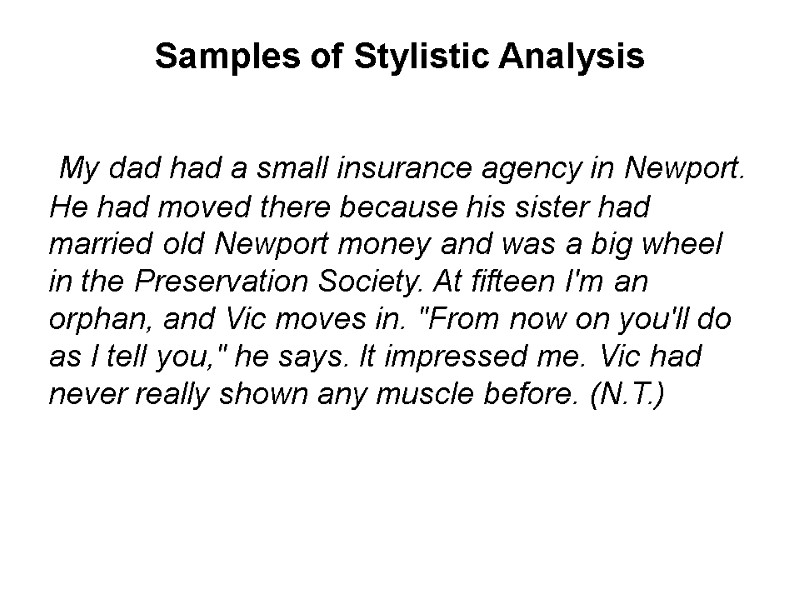
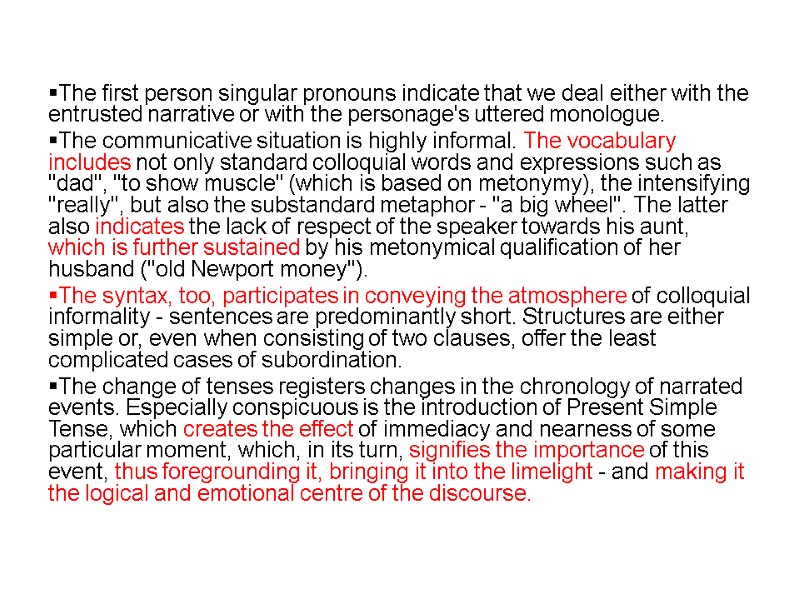
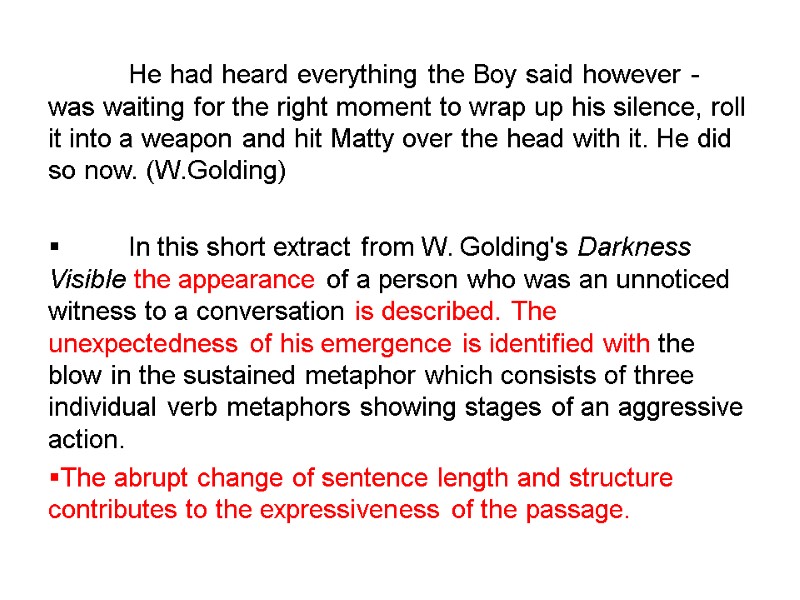
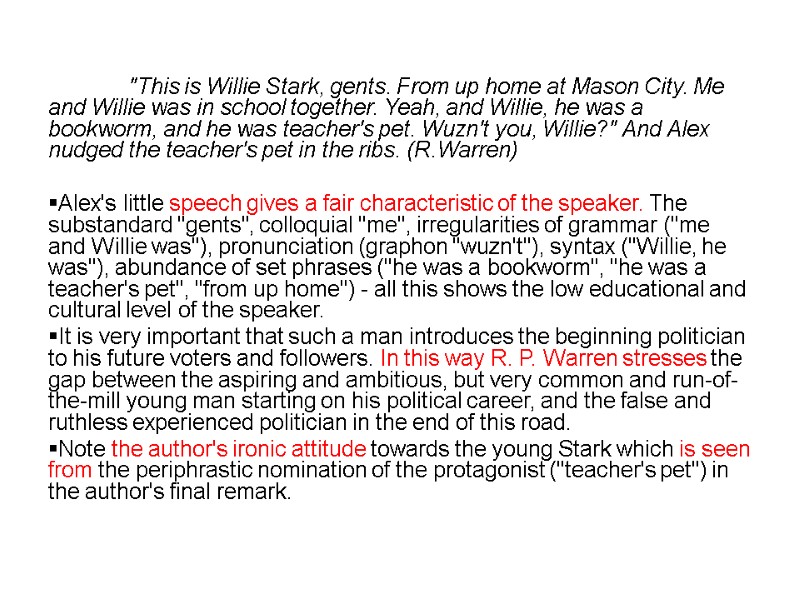
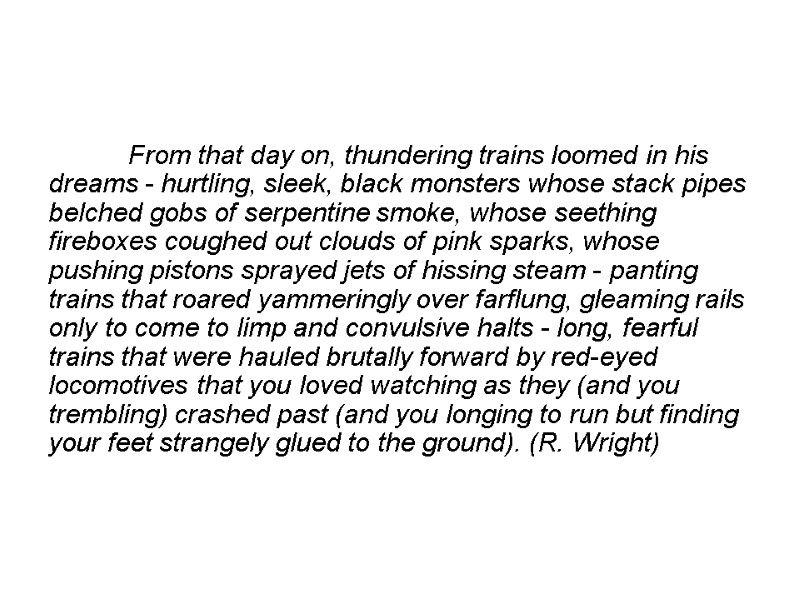
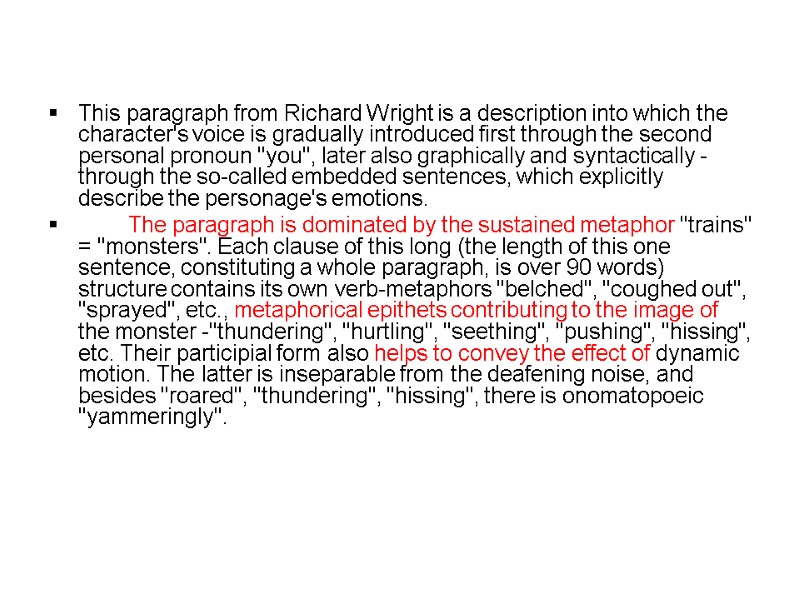
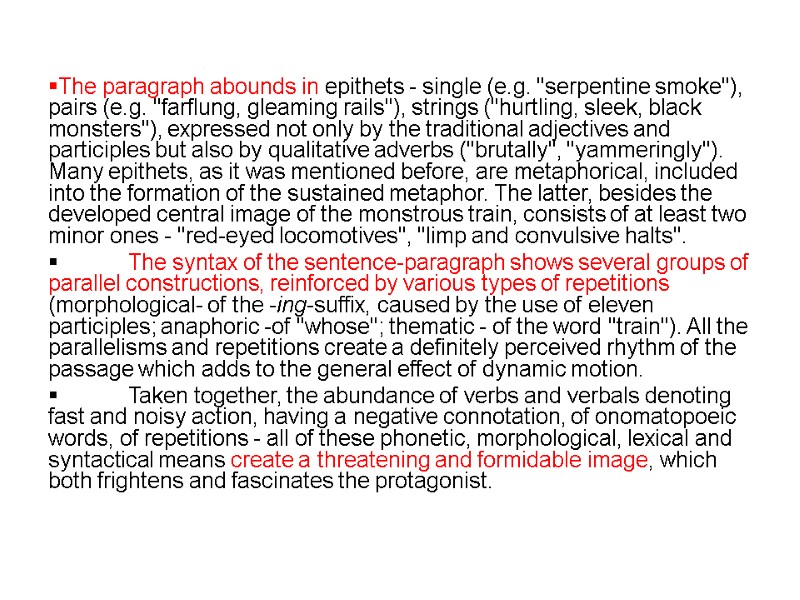
114-bakalavry_review.ppt
- Количество слайдов: 17
 A GUIDE TO LITERARY ANALYSIS The stylistic analysis of any literary text is aimed at reveling the subject matter of the text, which is sometimes buried deeply in the form, and investigating the language techniques used to express the author’s thoughts and ideas manifested in the text.
A GUIDE TO LITERARY ANALYSIS The stylistic analysis of any literary text is aimed at reveling the subject matter of the text, which is sometimes buried deeply in the form, and investigating the language techniques used to express the author’s thoughts and ideas manifested in the text.
 A GUIDE TO LITERARY ANALYSIS The complex stylistic analysis of a literary text can be made in stages and should cover the following issues: 1. Commenting on the title of the story (chapter). The title itself is an informational signal, which often suggests the focus of the work and may provide clues about it. In this case the title may serve the following functions: nominative, prospective, misleading, intriguing or thought-provoking. 2. Defining the theme (the central idea, the basic problem, or the underlying thought) of the text in question. The theme can be understood as the represented aspect of life, which the story illustrates.
A GUIDE TO LITERARY ANALYSIS The complex stylistic analysis of a literary text can be made in stages and should cover the following issues: 1. Commenting on the title of the story (chapter). The title itself is an informational signal, which often suggests the focus of the work and may provide clues about it. In this case the title may serve the following functions: nominative, prospective, misleading, intriguing or thought-provoking. 2. Defining the theme (the central idea, the basic problem, or the underlying thought) of the text in question. The theme can be understood as the represented aspect of life, which the story illustrates.
 A GUIDE TO LITERARY ANALYSIS 3. Stating the form of presentation. A literary text in prose seldom represents one form of presentation. It is usually a combination of several forms of presentation, one or two being dominant: the author’s narrative: narration / speculation / description / a portrait; direct speech: dialogue, monologue, conversation; reported speech : inner (unuttered) or outer (uttered) reported speech.
A GUIDE TO LITERARY ANALYSIS 3. Stating the form of presentation. A literary text in prose seldom represents one form of presentation. It is usually a combination of several forms of presentation, one or two being dominant: the author’s narrative: narration / speculation / description / a portrait; direct speech: dialogue, monologue, conversation; reported speech : inner (unuttered) or outer (uttered) reported speech.
 A GUIDE TO LITERARY ANALYSIS 4. Identifying the type of narration and its advantages. In literary text two main types of narration are employed: the 1st person narration (subjectivized), which is used to make the text sound more personal; create the atmosphere of intimacy, give a reliable and first-hand information, make the text more vivid and emotional, create the effect of authenticity; a reader becomes a participant of the events etc.).
A GUIDE TO LITERARY ANALYSIS 4. Identifying the type of narration and its advantages. In literary text two main types of narration are employed: the 1st person narration (subjectivized), which is used to make the text sound more personal; create the atmosphere of intimacy, give a reliable and first-hand information, make the text more vivid and emotional, create the effect of authenticity; a reader becomes a participant of the events etc.).
 A GUIDE TO LITERARY ANALYSIS the 3d person narration (objectivised). The narrator focuses on some other character(s). He may have directs (unlimited) knowledge of the characters and act as an observer (witness). He may have no direct (limited) knowledge of the character and act as an entirely anonymous character. The technique is used to make the narration more objective, sometimes matter-of-fact, and free from any personal attitude. The 2nd person narration
A GUIDE TO LITERARY ANALYSIS the 3d person narration (objectivised). The narrator focuses on some other character(s). He may have directs (unlimited) knowledge of the characters and act as an observer (witness). He may have no direct (limited) knowledge of the character and act as an entirely anonymous character. The technique is used to make the narration more objective, sometimes matter-of-fact, and free from any personal attitude. The 2nd person narration
 A GUIDE TO LITERARY ANALYSIS 4. Compositional analysis Composition can be viewed as the interrelation between different components of a literary text. The compositional structure of the text plays a very important role in shaping and revealing the author’s message. One may come across the following compositional parts:
A GUIDE TO LITERARY ANALYSIS 4. Compositional analysis Composition can be viewed as the interrelation between different components of a literary text. The compositional structure of the text plays a very important role in shaping and revealing the author’s message. One may come across the following compositional parts:
 A GUIDE TO LITERARY ANALYSIS exposition contains a short presentation of time, place and characters of the story. complication is a separate incident helping to unfold the action, and might involve thoughts and feelings as well. development of events (the arrangement of meaningful events in which the characters try to resolve the conflict). No matter how insignificant or deceptively casual, the events of the story are meant to suggest the character’s morals and motives. climax is the most decisive moment on which the fate of the characters and the final action depends on. denouement means ‘the untying of a knit’ which is precisely what happens in this phase. Not all stories have a denouement, some stories and right after a climax. It is worth noting that not all compositional parts are always found in each particular text. For each particular text its compositional structure is very specific.
A GUIDE TO LITERARY ANALYSIS exposition contains a short presentation of time, place and characters of the story. complication is a separate incident helping to unfold the action, and might involve thoughts and feelings as well. development of events (the arrangement of meaningful events in which the characters try to resolve the conflict). No matter how insignificant or deceptively casual, the events of the story are meant to suggest the character’s morals and motives. climax is the most decisive moment on which the fate of the characters and the final action depends on. denouement means ‘the untying of a knit’ which is precisely what happens in this phase. Not all stories have a denouement, some stories and right after a climax. It is worth noting that not all compositional parts are always found in each particular text. For each particular text its compositional structure is very specific.
 A GUIDE TO LITERARY ANALYSIS 5. The dominant emotional tone of the text (the author’s attitude to his subject-matter). It may be neutral, lyrical, dramatic, ironical, humorous, sarcastic, etc. One of the clearest indications of the tone of a story (passage) is the style in which it is written.
A GUIDE TO LITERARY ANALYSIS 5. The dominant emotional tone of the text (the author’s attitude to his subject-matter). It may be neutral, lyrical, dramatic, ironical, humorous, sarcastic, etc. One of the clearest indications of the tone of a story (passage) is the style in which it is written.
 A GUIDE TO LITERARY ANALYSIS 6. Identifying EMs ans SDs on all levels and the effect they produce: phonetic; graphical; morphological; lexical, phraseological; semasiological; syntactical
A GUIDE TO LITERARY ANALYSIS 6. Identifying EMs ans SDs on all levels and the effect they produce: phonetic; graphical; morphological; lexical, phraseological; semasiological; syntactical
 A GUIDE TO LITERARY ANALYSIS 8. Conceptual information contained in the whole text and its massage. 9. Summing up the analysis: the task is to show the unity of all EMs and SDs, as well as compositional arrangement of the text, as the way of expressing the underlying thought and the author’s communicative aim, to reveal the individuality of the writer’s style as the peculiar treatment of language means. 10. Personal impression of the text.
A GUIDE TO LITERARY ANALYSIS 8. Conceptual information contained in the whole text and its massage. 9. Summing up the analysis: the task is to show the unity of all EMs and SDs, as well as compositional arrangement of the text, as the way of expressing the underlying thought and the author’s communicative aim, to reveal the individuality of the writer’s style as the peculiar treatment of language means. 10. Personal impression of the text.
 Samples of Stylistic Analysis My dad had a small insurance agency in Newport. He had moved there because his sister had married old Newport money and was a big wheel in the Preservation Society. At fifteen I'm an orphan, and Vic moves in. "From now on you'll do as I tell you," he says. It impressed me. Vic had never really shown any muscle before. (N.T.)
Samples of Stylistic Analysis My dad had a small insurance agency in Newport. He had moved there because his sister had married old Newport money and was a big wheel in the Preservation Society. At fifteen I'm an orphan, and Vic moves in. "From now on you'll do as I tell you," he says. It impressed me. Vic had never really shown any muscle before. (N.T.)
 The first person singular pronouns indicate that we deal either with the entrusted narrative or with the personage's uttered monologue. The communicative situation is highly informal. The vocabulary includes not only standard colloquial words and expressions such as "dad", "to show muscle" (which is based on metonymy), the intensifying "really'', but also the substandard metaphor - "a big wheel". The latter also indicates the lack of respect of the speaker towards his aunt, which is further sustained by his metonymical qualification of her husband ("old Newport money"). The syntax, too, participates in conveying the atmosphere of colloquial informality - sentences are predominantly short. Structures are either simple or, even when consisting of two clauses, offer the least complicated cases of subordination. The change of tenses registers changes in the chronology of narrated events. Especially conspicuous is the introduction of Present Simple Tense, which creates the effect of immediacy and nearness of some particular moment, which, in its turn, signifies the importance of this event, thus foregrounding it, bringing it into the limelight - and making it the logical and emotional centre of the discourse.
The first person singular pronouns indicate that we deal either with the entrusted narrative or with the personage's uttered monologue. The communicative situation is highly informal. The vocabulary includes not only standard colloquial words and expressions such as "dad", "to show muscle" (which is based on metonymy), the intensifying "really'', but also the substandard metaphor - "a big wheel". The latter also indicates the lack of respect of the speaker towards his aunt, which is further sustained by his metonymical qualification of her husband ("old Newport money"). The syntax, too, participates in conveying the atmosphere of colloquial informality - sentences are predominantly short. Structures are either simple or, even when consisting of two clauses, offer the least complicated cases of subordination. The change of tenses registers changes in the chronology of narrated events. Especially conspicuous is the introduction of Present Simple Tense, which creates the effect of immediacy and nearness of some particular moment, which, in its turn, signifies the importance of this event, thus foregrounding it, bringing it into the limelight - and making it the logical and emotional centre of the discourse.
 He had heard everything the Boy said however - was waiting for the right moment to wrap up his silence, roll it into a weapon and hit Matty over the head with it. He did so now. (W.Golding) In this short extract from W. Golding's Darkness Visible the appearance of a person who was an unnoticed witness to a conversation is described. The unexpectedness of his emergence is identified with the blow in the sustained metaphor which consists of three individual verb metaphors showing stages of an aggressive action. The abrupt change of sentence length and structure contributes to the expressiveness of the passage.
He had heard everything the Boy said however - was waiting for the right moment to wrap up his silence, roll it into a weapon and hit Matty over the head with it. He did so now. (W.Golding) In this short extract from W. Golding's Darkness Visible the appearance of a person who was an unnoticed witness to a conversation is described. The unexpectedness of his emergence is identified with the blow in the sustained metaphor which consists of three individual verb metaphors showing stages of an aggressive action. The abrupt change of sentence length and structure contributes to the expressiveness of the passage.
 "This is Willie Stark, gents. From up home at Mason City. Me and Willie was in school together. Yeah, and Willie, he was a bookworm, and he was teacher's pet. Wuzn't you, Willie?" And Alex nudged the teacher's pet in the ribs. (R.Warren) Alex's little speech gives a fair characteristic of the speaker. The substandard "gents", colloquial "me", irregularities of grammar ("me and Willie was"), pronunciation (graphon "wuzn't"), syntax ("Willie, he was"), abundance of set phrases ("he was a bookworm", "he was a teacher's pet", "from up home") - all this shows the low educational and cultural level of the speaker. It is very important that such a man introduces the beginning politician to his future voters and followers. In this way R. P. Warren stresses the gap between the aspiring and ambitious, but very common and run-of-the-mill young man starting on his political career, and the false and ruthless experienced politician in the end of this road. Note the author's ironic attitude towards the young Stark which is seen from the periphrastic nomination of the protagonist ("teacher's pet") in the author's final remark.
"This is Willie Stark, gents. From up home at Mason City. Me and Willie was in school together. Yeah, and Willie, he was a bookworm, and he was teacher's pet. Wuzn't you, Willie?" And Alex nudged the teacher's pet in the ribs. (R.Warren) Alex's little speech gives a fair characteristic of the speaker. The substandard "gents", colloquial "me", irregularities of grammar ("me and Willie was"), pronunciation (graphon "wuzn't"), syntax ("Willie, he was"), abundance of set phrases ("he was a bookworm", "he was a teacher's pet", "from up home") - all this shows the low educational and cultural level of the speaker. It is very important that such a man introduces the beginning politician to his future voters and followers. In this way R. P. Warren stresses the gap between the aspiring and ambitious, but very common and run-of-the-mill young man starting on his political career, and the false and ruthless experienced politician in the end of this road. Note the author's ironic attitude towards the young Stark which is seen from the periphrastic nomination of the protagonist ("teacher's pet") in the author's final remark.
 From that day on, thundering trains loomed in his dreams - hurtling, sleek, black monsters whose stack pipes belched gobs of serpentine smoke, whose seething fireboxes coughed out clouds of pink sparks, whose pushing pistons sprayed jets of hissing steam - panting trains that roared yammeringly over farflung, gleaming rails only to come to limp and convulsive halts - long, fearful trains that were hauled brutally forward by red-eyed locomotives that you loved watching as they (and you trembling) crashed past (and you longing to run but finding your feet strangely glued to the ground). (R. Wright)
From that day on, thundering trains loomed in his dreams - hurtling, sleek, black monsters whose stack pipes belched gobs of serpentine smoke, whose seething fireboxes coughed out clouds of pink sparks, whose pushing pistons sprayed jets of hissing steam - panting trains that roared yammeringly over farflung, gleaming rails only to come to limp and convulsive halts - long, fearful trains that were hauled brutally forward by red-eyed locomotives that you loved watching as they (and you trembling) crashed past (and you longing to run but finding your feet strangely glued to the ground). (R. Wright)
 This paragraph from Richard Wright is a description into which the character's voice is gradually introduced first through the second personal pronoun "you", later also graphically and syntactically - through the so-called embedded sentences, which explicitly describe the personage's emotions. The paragraph is dominated by the sustained metaphor "trains" = "monsters". Each clause of this long (the length of this one sentence, constituting a whole paragraph, is over 90 words) structure contains its own verb-metaphors "belched", "coughed out", "sprayed", etc., metaphorical epithets contributing to the image of the monster -"thundering", "hurtling", "seething", "pushing", "hissing", etc. Their participial form also helps to convey the effect of dynamic motion. The latter is inseparable from the deafening noise, and besides "roared", "thundering", "hissing", there is onomatopoeic "yammeringly".
This paragraph from Richard Wright is a description into which the character's voice is gradually introduced first through the second personal pronoun "you", later also graphically and syntactically - through the so-called embedded sentences, which explicitly describe the personage's emotions. The paragraph is dominated by the sustained metaphor "trains" = "monsters". Each clause of this long (the length of this one sentence, constituting a whole paragraph, is over 90 words) structure contains its own verb-metaphors "belched", "coughed out", "sprayed", etc., metaphorical epithets contributing to the image of the monster -"thundering", "hurtling", "seething", "pushing", "hissing", etc. Their participial form also helps to convey the effect of dynamic motion. The latter is inseparable from the deafening noise, and besides "roared", "thundering", "hissing", there is onomatopoeic "yammeringly".
 The paragraph abounds in epithets - single (e.g. "serpentine smoke"), pairs (e.g. "farflung, gleaming rails"), strings ("hurtling, sleek, black monsters"), expressed not only by the traditional adjectives and participles but also by qualitative adverbs ("brutally", "yammeringly"). Many epithets, as it was mentioned before, are metaphorical, included into the formation of the sustained metaphor. The latter, besides the developed central image of the monstrous train, consists of at least two minor ones - "red-eyed locomotives", "limp and convulsive halts". The syntax of the sentence-paragraph shows several groups of parallel constructions, reinforced by various types of repetitions (morphological- of the -ing-suffix, caused by the use of eleven participles; anaphoric -of "whose"; thematic - of the word "train"). All the parallelisms and repetitions create a definitely perceived rhythm of the passage which adds to the general effect of dynamic motion. Taken together, the abundance of verbs and verbals denoting fast and noisy action, having a negative connotation, of onomatopoeic words, of repetitions - all of these phonetic, morphological, lexical and syntactical means create a threatening and formidable image, which both frightens and fascinates the protagonist.
The paragraph abounds in epithets - single (e.g. "serpentine smoke"), pairs (e.g. "farflung, gleaming rails"), strings ("hurtling, sleek, black monsters"), expressed not only by the traditional adjectives and participles but also by qualitative adverbs ("brutally", "yammeringly"). Many epithets, as it was mentioned before, are metaphorical, included into the formation of the sustained metaphor. The latter, besides the developed central image of the monstrous train, consists of at least two minor ones - "red-eyed locomotives", "limp and convulsive halts". The syntax of the sentence-paragraph shows several groups of parallel constructions, reinforced by various types of repetitions (morphological- of the -ing-suffix, caused by the use of eleven participles; anaphoric -of "whose"; thematic - of the word "train"). All the parallelisms and repetitions create a definitely perceived rhythm of the passage which adds to the general effect of dynamic motion. Taken together, the abundance of verbs and verbals denoting fast and noisy action, having a negative connotation, of onomatopoeic words, of repetitions - all of these phonetic, morphological, lexical and syntactical means create a threatening and formidable image, which both frightens and fascinates the protagonist.

